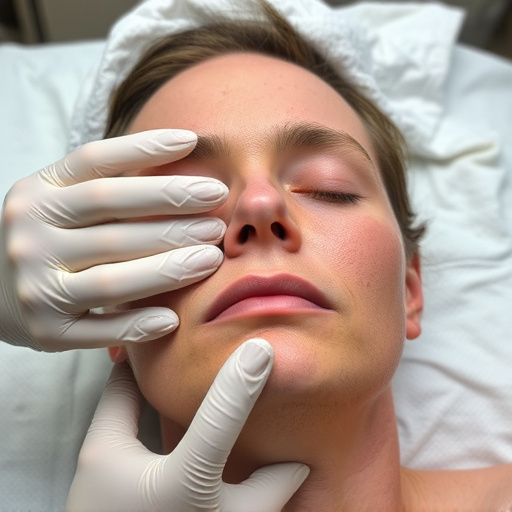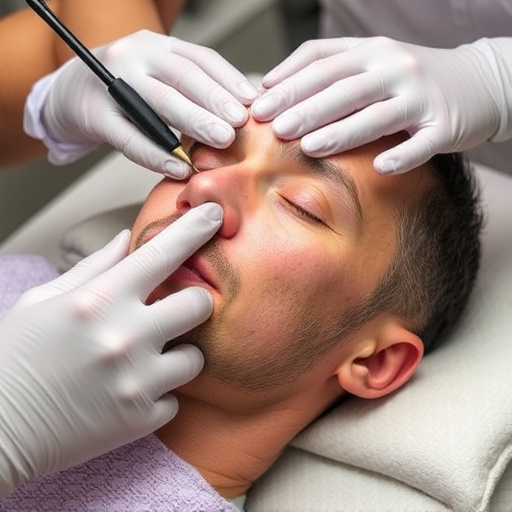Unleash Youthful Skin: Natural Fine Lines Treatment Through Collagen Boosting
Collagen, key to skin health and elasticity, decreases with age, leading to wrinkles. Fine lines tre…….
In the ever-evolving landscape of healthcare, fine lines treatment has emerged as a game-changer, offering targeted interventions with profound implications for patient outcomes. This innovative approach leverages advanced technologies and a deep understanding of genetic nuances to personalize treatments, catering to the unique needs of each individual. As we delve into this comprehensive article, readers will uncover the multifaceted world of fine lines treatment, its global impact, economic considerations, technological breakthroughs, regulatory frameworks, and the challenges it faces. By exploring these aspects, we aim to provide a holistic perspective on why this field is not just a trend but a crucial component of modern healthcare.
Fine lines treatment, at its core, involves the precise administration of medical interventions tailored to an individual’s genetic makeup and specific health condition. It transcends traditional one-size-fits-all approaches by recognizing that every person’s body reacts differently to treatments. This methodology is particularly prominent in oncology, where personalized cancer therapies have revolutionized patient care.
Historically, medicine has primarily relied on broad-spectrum treatments, treating symptoms without delving into the intricate genetic underpinnings of diseases. However, advancements in genomics, bioinformatics, and biotechnologies have enabled healthcare professionals to move towards a more precise and effective model. By decoding an individual’s genetic code, fine lines treatment aims to identify specific mutations, variations, or biological markers associated with a disease, allowing for targeted interventions.
The significance of fine lines treatment lies in its ability to:
Enhance Treatment Efficacy: Targeted therapies have shown remarkable success rates in treating various conditions, including cancer, rare diseases, and genetic disorders. By addressing the root cause, these treatments can be more potent and yield better outcomes.
Minimize Side Effects: As treatments are customized to individual genetics, there is a reduced risk of adverse reactions commonly associated with conventional therapies. This precision approach ensures that treatments are tailored to avoid unnecessary harm.
Personalize Healthcare: It empowers healthcare providers to offer individualized care plans, taking into account not just the disease but also the patient’s unique characteristics, thereby fostering better patient satisfaction and adherence to treatment regimens.
The impact of fine lines treatment is felt worldwide, with key trends shaping its development and adoption:
Global Cancer Treatment Revolution: Personalized oncology treatments have gained significant traction, especially in the battle against cancer. Countries like the United States, Canada, and several European nations are leading the way in precision oncology, with research indicating improved survival rates and reduced side effects.
Regional Disparities: While advancements are evident globally, there are still regional disparities. Developing countries often face challenges in implementing fine lines treatment due to limited resources, inadequate infrastructure, and a lack of trained personnel. However, initiatives by international organizations and governmental bodies aim to bridge this gap.
Technological Diffusion: The rapid adoption of advanced technologies, such as genome sequencing and artificial intelligence (AI), has accelerated the global reach of fine lines treatment. These tools enable faster and more accurate diagnosis and treatment planning, making precision healthcare increasingly accessible.
Public Awareness and Education: Growing public awareness campaigns have played a pivotal role in promoting the benefits of personalized medicine. Educated patients are demanding more tailored care options, putting pressure on healthcare systems to adopt these innovative practices.
The economic implications of fine lines treatment are multifaceted, influencing various sectors within healthcare and pharmaceutical industries:
Market Growth: The global market for personalized medicine is projected to grow significantly in the coming years. According to a report by Grand View Research, the global precision medicine market size was valued at USD 126.3 billion in 2020 and is expected to expand at a compound annual growth rate (CAGR) of 18.7% from 2021 to 2028. This growth is driven by increasing research and development (R&D) investments, rising healthcare expenditure, and growing demand for targeted therapies.
Investment Landscape: Venture capital firms and pharmaceutical companies are increasingly investing in fine lines treatment technologies and startups. These investments fuel innovation, accelerate product development, and bring cutting-edge treatments to market faster.
Cost Implications: While personalized treatments offer long-term benefits, they often carry higher upfront costs. This has led to discussions about healthcare system sustainability and value-based care models. Payers and policymakers are exploring strategies to balance the benefits of precision medicine with cost considerations, such as performance-based contracts and risk-sharing arrangements.
Access and Affordability: Ensuring equitable access to fine lines treatment remains a challenge. Addressing affordability issues is crucial to prevent disparities in healthcare outcomes. Value frameworks that consider long-term patient outcomes and quality-adjusted life years (QALYs) can help make these treatments more accessible.
Technological innovations have been pivotal in shaping fine lines treatment, enabling more accurate diagnoses and effective interventions:
| Technology | Description | Impact on Fine Lines Treatment |
|---|---|---|
| Genome Sequencing | High-throughput sequencing technologies allow for rapid and cost-effective decoding of an individual’s genetic code. | Enables the identification of disease-causing mutations, aids in diagnosis, and guides treatment selection by revealing genetic variations that respond differently to drugs. |
| Artificial Intelligence (AI) | AI algorithms analyze vast amounts of data, including genetic information and medical records, to provide insights and predictions. | Improves diagnostic accuracy, assists in drug discovery, and helps identify optimal treatment combinations by learning from existing patient data. |
| Advanced Imaging Technologies | Techniques like magnetic resonance imaging (MRI) and positron emission tomography (PET) offer detailed visualizations of biological processes. | Facilitates precise disease monitoring, enables early detection, and aids in assessing treatment response, especially in cancer care. |
| Robotic Surgery | Robotic systems enhance surgical precision, minimizing trauma and improving outcomes. | Used for complex procedures, robotic surgery ensures more accurate administration of treatments, including gene therapies and targeted deliveries. |
| Nanotechnology | Nanoparticles can carry drugs or genetic material, enabling targeted drug delivery. | Offers potential for more effective cancer treatments by delivering chemotherapeutics directly to tumors while minimizing side effects. |
These advancements have collectively enhanced the capabilities of healthcare professionals, enabling them to offer more precise and personalized care.
The development and implementation of fine lines treatment are guided by a complex web of policies and regulations, ensuring patient safety and ethical practices:
Ethical Considerations: Genetic information is highly sensitive, raising concerns about privacy and potential discrimination. Regulations must protect patients’ rights to genetic data while fostering responsible research and treatment practices.
Clinical Trials and Drug Approval: Stringent guidelines for clinical trials are essential to ensure the safety and efficacy of new treatments. Regulatory bodies like the U.S. Food and Drug Administration (FDA) and the European Medicines Agency (EMA) play a crucial role in approving novel therapies.
Data Privacy Laws: With the rise of digital health records, data privacy laws such as HIPAA (Health Insurance Portability and Accountability Act) in the US and GDPR (General Data Protection Regulation) in Europe are vital to protect patient information.
Incentives and Reimbursement Policies: Governments and healthcare payers implement policies to encourage the adoption of precision treatments. Incentives, risk-sharing models, and value-based reimbursement can promote access and improve healthcare outcomes.
Despite its numerous advantages, fine lines treatment faces several challenges and criticisms that require careful consideration:
High Upfront Costs: As mentioned earlier, personalized treatments often carry higher initial costs. This can deter healthcare providers and patients, especially in resource-constrained settings.
Data Accessibility and Bias: Access to comprehensive genetic data is unevenly distributed globally. Additionally, biases in existing datasets may lead to inaccurate predictions for certain populations, highlighting the need for diverse and representative data collection.
Technical Expertise and Training: The implementation of fine lines treatment requires specialized skills and knowledge. Healthcare professionals must undergo training to stay abreast of technological advancements and interpret complex data.
Regulatory Hurdles: Navigating regulatory frameworks can be complex and time-consuming, delaying the market entry of innovative treatments. Streamlining approval processes while maintaining safety standards is essential.
Actionable Solutions:
Public-Private Partnerships: Collaboration between governments, pharmaceutical companies, and research institutions can help address infrastructure gaps, fund R&D, and improve data accessibility, especially in developing countries.
Open Data Initiatives: Encouraging data sharing and collaboration among researchers can lead to more robust and inclusive datasets, reducing biases and improving treatment predictions for diverse populations.
Continuous Education: Healthcare providers should engage in ongoing training programs to stay updated with technological advancements and best practices in fine lines treatment.
Streamlined Regulatory Processes: Reviewing and simplifying regulatory requirements while maintaining oversight can accelerate the development and approval of new treatments without compromising safety.
The following case studies illustrate successful applications of fine lines treatment, showcasing its potential impact:
Case Study 1: Precision Oncology in the United States
A leading cancer hospital in the US implemented a precision oncology program, offering targeted therapies based on individual tumor profiles. The program involved comprehensive genetic testing and advanced imaging to tailor treatments for each patient. Results showed improved response rates and longer progression-free survival times, particularly in patients with rare cancer subtypes. This initiative also demonstrated reduced side effects, leading to higher patient satisfaction.
Case Study 2: Rare Disease Treatment in Europe
A European consortium developed a platform that facilitates the sharing of genetic data among researchers and clinicians worldwide for rare diseases. This collaborative effort enabled faster identification of disease-causing genes and informed the development of targeted therapies. As a result, patients with previously undiagnosed rare conditions received accurate diagnoses and access to specialized treatments, improving their quality of life significantly.
Case Study 3: Gene Therapy for Spinal Muscular Atrophy (SMA)
Researchers successfully developed a gene therapy for SMA, a devastating genetic disorder affecting muscle movement. The treatment involves delivering a functional copy of the SMN1 gene to patients’ cells, leading to improved motor function and increased lifespan. Clinical trials demonstrated remarkable outcomes, providing hope for families affected by this disease.
The future of fine lines treatment is filled with promising possibilities, driven by emerging trends and technological innovations:
Advanced Genomics: The next generation of genome sequencing technologies will offer even more comprehensive insights into genetic variations, enabling more precise predictions and treatments.
Personalized Immunotherapy: Building on the success of cancer immunotherapies, researchers are exploring ways to personalize these treatments based on individual immune profiles, enhancing their effectiveness against various cancers.
Digital Health and Telemedicine: Digital tools and telemedicine platforms can improve patient monitoring, facilitate remote consultations, and enhance access to fine lines treatment, especially in rural or underserved areas.
Global Collaboration: International partnerships will be crucial in addressing disparities and ensuring equitable access to precision treatments globally. Sharing knowledge, resources, and best practices can accelerate progress.
Fine lines treatment represents a significant leap forward in healthcare, offering personalized approaches to disease management with profound implications for patient outcomes. As we’ve explored throughout this article, its global impact is evident, with advancements driving transformation in oncology, rare diseases, and beyond. While challenges remain, from cost considerations to data accessibility, the future prospects are promising.
The ongoing evolution of fine lines treatment underscores the importance of continued investment, research, and collaboration among healthcare professionals, policymakers, and industry leaders. By embracing these innovative practices, we can unlock new frontiers in medicine, deliver tailored care to every patient, and ultimately improve lives worldwide.
Q: How does fine lines treatment differ from traditional medicine?
A: Fine lines treatment focuses on personalized care based on individual genetics and health conditions, while traditional medicine often employs one-size-fits-all approaches. The former considers unique variations and mutations, enabling more precise interventions.
Q: What are the potential benefits of fine lines treatment?
A: Key advantages include enhanced treatment efficacy, minimized side effects, improved patient satisfaction, and better long-term outcomes. It tailors care to the specific needs of each individual.
Q: Can fine lines treatment be expensive? How can this be addressed?
A: While personalized treatments may carry higher upfront costs, ongoing research and value-based healthcare models aim to balance benefits with affordability. Incentives, risk-sharing arrangements, and public-private partnerships can help make these treatments more accessible.
Q: How does technology play a role in fine lines treatment?
A: Advanced technologies like genome sequencing, AI, and robotic surgery are instrumental in precision healthcare. They enable accurate diagnoses, targeted interventions, and improved patient outcomes by providing detailed insights into genetic profiles and biological processes.
Q: Are there global efforts to ensure equitable access to fine lines treatment?
A: Yes, international organizations and governments are actively working to bridge the gap in access to personalized medicine. Collaboration, knowledge sharing, and funding initiatives aim to make these treatments more accessible globally, especially in developing countries.

Collagen, key to skin health and elasticity, decreases with age, leading to wrinkles. Fine lines tre…….

Aging skin develops fine lines, but diet and supplementation significantly influence their appearanc…….

Fine lines are influenced by age and environmental factors. Targeted skincare routines with specific…….

Fine lines and wrinkles are natural with age but can be managed effectively through early detection…….

Fine lines, though natural with age, can be mitigated through proactive skincare. Regular cleansing,…….

Fine lines, accelerated by environmental factors and lifestyle choices, manifest as expression and s…….

Understanding the holistic factors influencing fine lines treatment efficacy is key. Genetic predisp…….